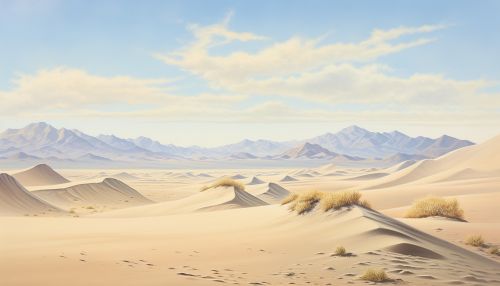Aeolian processes
Introduction
Aeolian processes, also known as wind erosion processes, are powerful forces in nature that shape the Earth's surface. These processes are responsible for the formation of many different types of landforms and are a key component of the Earth's geomorphic system. The term "aeolian" comes from Aeolus, the ancient Greek god of the wind, reflecting the role of wind in these processes.


Aeolian Processes: An Overview
Aeolian processes involve the movement and transportation of sediment by wind. These processes can occur anywhere on Earth where there is loose sediment and enough wind energy to move that sediment. The most common locations for aeolian processes are deserts, beaches, and areas with loose, dry soil.
Types of Aeolian Processes
There are three main types of aeolian processes: abrasion, attrition, and deflation. Each of these processes involves the movement of sediment by wind, but they differ in the specific mechanisms and results.
Abrasion
Abrasion is a process where wind-blown sediment wears down the surface of rocks or other geological features. This process can create unique landforms such as yardangs and ventifacts.
Attrition
Attrition is a process where wind-blown sediment particles collide with each other, causing them to break down into smaller particles. This process is responsible for the creation of sand and dust particles in the atmosphere.
Deflation
Deflation is a process where wind removes loose particles from the surface, often leaving behind a layer of larger particles that were too heavy to be moved by the wind. This process can create landforms such as desert pavements and blowouts.
Aeolian Landforms
Aeolian processes are responsible for the creation of a variety of unique landforms. These include dunes, loess deposits, and ergs.
Dunes
Dunes are mounds or ridges of sand or other loose sediment that have been piled up by the wind. Dunes can take on a variety of shapes and sizes, depending on the wind direction, sediment supply, and vegetation cover.
Loess Deposits
Loess deposits are accumulations of wind-blown silt that blanket large areas of the Earth's surface. These deposits are typically pale in color and can be several meters thick.
Ergs
Ergs are large, flat areas of desert covered with wind-swept sand. These areas can cover thousands of square kilometers and are among the most visually striking aeolian landforms.
Aeolian Processes and Climate
Aeolian processes play a significant role in the Earth's climate system. Wind erosion and dust emission can influence the Earth's radiation balance, cloud formation, and precipitation patterns. Additionally, aeolian processes can play a role in the global carbon cycle by influencing the distribution and storage of organic carbon.
Human Impact on Aeolian Processes
Human activities can significantly impact aeolian processes. Land use changes, such as deforestation and overgrazing, can increase the amount of loose sediment available for wind erosion. Additionally, climate change can alter wind patterns and increase the frequency and intensity of dust storms.
